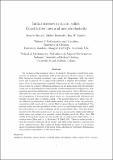| dc.contributor.author | Destrade, Michel | |
| dc.date.accessioned | 2013-02-12T12:10:41Z | |
| dc.date.available | 2013-02-12T12:10:41Z | |
| dc.date.issued | 2011 | |
| dc.identifier.citation | Shams, M., Destrade, M., & Ogden, R. W. Initial stresses in elastic solids: Constitutive laws and acoustoelasticity. Wave Motion, 48(7), 552-567. | en_US |
| dc.identifier.issn | 0165-2125 | |
| dc.identifier.uri | http://hdl.handle.net/10379/3232 | |
| dc.description.abstract | On the basis of the nonlinear theory of elasticity, the general constitutive equation for an isotropic hyperelastic solid in the presence of initial stress is derived. This derivation involves invariants that couple the deformation with the initial stress and in general, for a compressible material, it requires 10 invariants, reducing to 9 for an incompressible material. Expressions for the Cauchy and nominal stress tensors in a finitely deformed configuration are given along with the elasticity tensor and its specialization to the initially stressed undeformed configuration. The equations governing infinitesimal motions superimposed on a finite deformation are then used to study the combined effects of initial stress and finite deformation on the propagation of homogeneous plane waves in a homogeneously deformed and initially stressed solid of infinite extent. This general framework allows for various different specializations, which make contact with earlier works. In particular, connections with results derived within Biot's classical theory are highlighted. The general results are also specialized to the case of a small initial stress and a small pre-deformation, i.e. to the evaluation of the acoustoelastic effect. Here the formulas derived for the wave speeds cover the case of a second-order elastic solid without initial stress and subject to a uniaxial tension [Hughes and Kelly, Phys. Rev. 92 (1953) 1145] and are consistent with results for an undeformed solid subject to a residual stress [Man and Lu, J. Elasticity 17 (1987) 159]. These formulas provide a basis for acoustic evaluation of the second- and third-order elasticity constants and of the residual stresses. The results are further illustrated in respect of a prototype model of nonlinear elasticity with initial stress, allowing for both finite deformation and nonlinear dependence on the initial stress. | en_US |
| dc.format | application/pdf | en_US |
| dc.language.iso | en | en_US |
| dc.relation.ispartof | Wave Motion | en |
| dc.rights | Attribution-NonCommercial-NoDerivs 3.0 Ireland | |
| dc.rights.uri | https://creativecommons.org/licenses/by-nc-nd/3.0/ie/ | |
| dc.subject | Nonlinear elasticity | en_US |
| dc.subject | Initial stress | en_US |
| dc.subject | Residual stress | en_US |
| dc.subject | Invariants | en_US |
| dc.subject | Plane waves | en_US |
| dc.subject | Biot's theory | en_US |
| dc.title | Initial stresses in elastic solids: Constitutive laws and acoustoelasticity | en_US |
| dc.type | Article | en_US |
| dc.date.updated | 2012-12-21T21:44:58Z | |
| dc.local.publishedsource | http://dx.doi.org/10.1016/j.wavemoti.2011.04.004 | en_US |
| dc.description.peer-reviewed | peer-reviewed | |
| dc.contributor.funder | |~| | |
| dc.internal.rssid | 1276609 | |
| dc.local.contact | Michel Destrade, Room C202 Áras De Brún, School Of Mathematics, Nui Galway. Email: michel.destrade@nuigalway.ie | |
| dc.local.copyrightchecked | No | |
| dc.local.version | UPDATED | |
| nui.item.downloads | 467 | |


